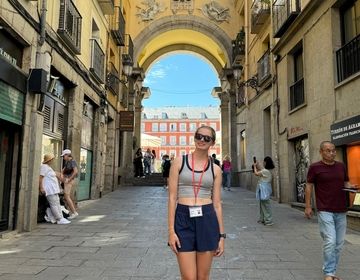Una Visita a San Ginés
On Thursday, our Language & Culture groups took a trip down to a very famous establishment here in Madrid: Chocolatería San Ginés. We had the opportunity to sit as a group and eat traditional Spanish churros with chocolate. This is a classic dish that many Spaniards have for breakfast just as one would have a coffee + a donut in the United States. However, chocolate, as it grows in the wild, is not native to the Spanish peninsula. Then how did it get here and become such a quintessential part of Spanish culture? Well, we turned around and asked our own students to see what they thought...
How did chocolate end up in Spain if it's not native to the country?
They brought it here from somewhere else.
After Spain colonized the Americas, they brought it back here.
I really don't know actually.
Many students knew about the origins of chocolate, some didn't, but either way we were able to inform everybody about the history of chocolate and how it has impacted Spanish culture over time. Originally, chocolate hails from the region of ancient Mesoamerica, or modern day Mexico, and when Spanish explorers went to conquer the lands of the Americas they brought back cacao to Spain. At first, it was something that only the rich could afford because of its distinction as a status symbol, but over time it became more accesible to the general public as producers would "cut" the product with other ingredients to make it cheaper.
Again, over time it became adopted by the wider public and more and more people became keen on the flavor. In fact, the population of Spain became so obsessed with chocolate to the point that the authorities decreed in 1644 that chocolate was BANNED from being sold to the public, at least in the drinkable form. This was done to prevent people from drinking it in public spaces after it became such a cultural phenomenon.
[Fun Fact]
Chocolatería San Ginés has been operating in Madrid since 1894 which makes it 130 years old this year!
Related Posts

Segovia - Where History Meets Adventure
Read on to find out about castles, kayaks, and culture!

Bringing Madrid Home: How to Infuse Your Wardrobe with Summery Spanish Flair
This week Global Navigator Kate Hutchinson is going to teach us about her experience with fashion in Madrid!! Here is what Kate has learned this month: From colorful patterns to... keep reading
¡Vamos a la Playa! A Weekend Getaway in Valencia
In true Spanish fashion, we escaped to the Mediterranean city, Valencia. At around 12:30 pm after class, we set off to the east of Spain! The students were so excited... keep reading

